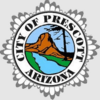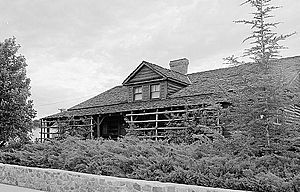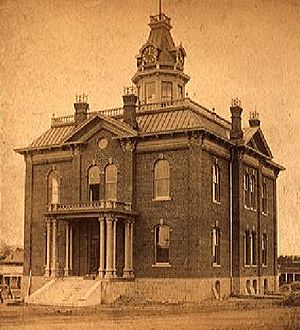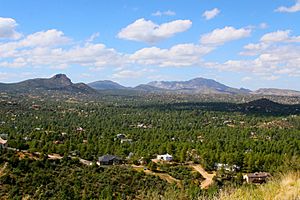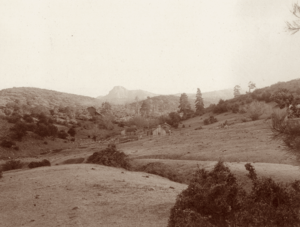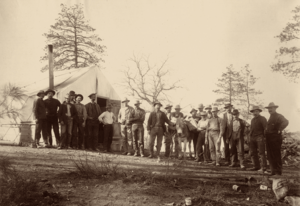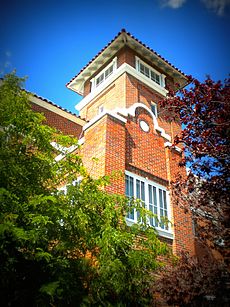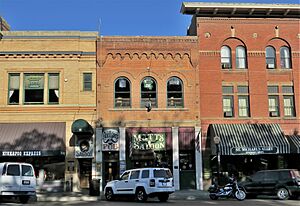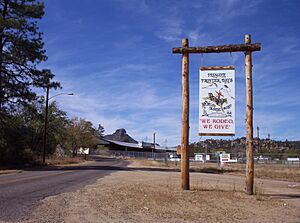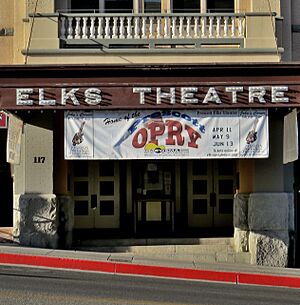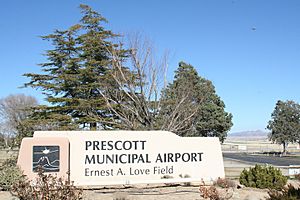Prescott, Arizona facts for kids
Quick facts for kids
Prescott
|
|||
|---|---|---|---|
|
City
|
|||
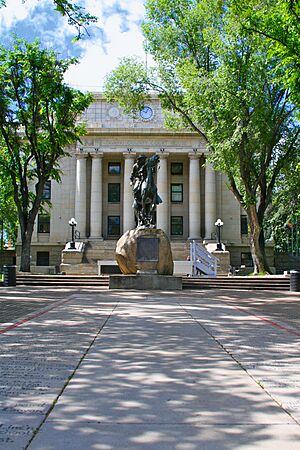
Courthouse and Buckey O'Neill statue
|
|||
|
|||
| Motto(s):
"Welcome to Everybody's Hometown"
|
|||
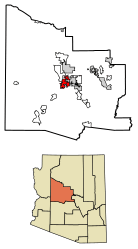
Location of Prescott in Yavapai County, Arizona
|
|||
| Country | United States | ||
| State | Arizona | ||
| County | Yavapai | ||
| Incorporated | 1881 | ||
| Named for | William H. Prescott | ||
| Government | |||
| • Type | Council-manager | ||
| Area | |||
| • City | 45.21 sq mi (117.09 km2) | ||
| • Land | 44.97 sq mi (116.47 km2) | ||
| • Water | 0.24 sq mi (0.62 km2) | ||
| Elevation | 5,319 ft (1,621 m) | ||
| Population
(2020)
|
|||
| • City | 45,827 | ||
| • Density | 1,019.08/sq mi (393.47/km2) | ||
| • Metro | 129,643 (Landscan) | ||
| Time zone | UTC−7 (MST (no DST)) | ||
| ZIP codes |
86301–86305 & 86318
|
||
| Area code(s) | 928 | ||
| FIPS code | 04-57380 | ||
| GNIS feature ID | 2411487 | ||
Prescott (/ˈprɛskət/ PRESS-kət) is a city in Yavapai County, Arizona, United States. It is also the county seat, which means it's the main town for the county's government. In 2020, about 45,827 people lived there.
Prescott has an interesting past. In 1864, it became the capital of the Arizona Territory. This was a temporary capital, taking over from Fort Whipple. The capital moved to Tucson in 1867. But Prescott became the capital again in 1877, before Phoenix took over in 1889.
This city was once a busy place for gold and silver mining. Many settlers came here, which sometimes led to conflicts with local Native American tribes like the Yavapai and Apache. Fort Whipple was built nearby and served as a base. Prescott was known as a "wild west" town in the late 1800s. Famous people like Doc Holliday and Virgil Earp lived here. The town, mostly built of wood, burned down several times in the early 1900s. After that, it was rebuilt with stronger brick buildings.
Today, Prescott is a popular place for tourists, especially because of its history. It hosts the "World's Oldest Rodeo," which has been happening every year since 1888. This famous rodeo attracts about 35,000 visitors each year.
Prescott is part of a group of towns called the "Quad-City" area. This includes Prescott Valley, Chino Valley, and Dewey-Humboldt. Sometimes, other nearby small towns are also included. The Yavapai-Prescott Indian Tribe has a reservation right next to Prescott. The city is also located in the Granite Creek area, where Miller Creek and Granite Creek meet.
Exploring Prescott's Past: A Look at Its History
The first site for Prescott was chosen by Arizona Territorial Governor John Noble Goodwin. He picked a spot about 20 kilometers south of the temporary capital. This new town was named after historian William H. Prescott. The first land sales happened in June 1864. Prescott officially became a city in 1880.
Prescott was the capital of Arizona Territory for a few years. It was the capital from 1864 to 1867. Then, the capital moved to Tucson. Prescott became the capital again in 1877. Finally, in 1889, Phoenix became the permanent capital.
The Sharlot Hall Museum in Prescott tells many stories about the territory's history. The Museum of Indigenous People and Phippen Museum also have local collections. Downtown Prescott has a famous area called Whiskey Row. It has many old buildings, including The Palace, which is Arizona's oldest restaurant and bar. Many buildings there are now shops, art galleries, and restaurants.
Prescott is also home to the Arizona Pioneers' Home. This place opened in 1911 to care for people who helped build Arizona. It later expanded to include a hospital for people who worked in mines.
After several big fires in the early 1900s, downtown Prescott was rebuilt with brick. The central courthouse plaza is a beautiful grassy area with large elm trees. It's a popular spot for events and performances, especially in the summer.
Barry Goldwater, who ran for president in 1964, started his campaign from the Prescott courthouse. In 2013, 19 brave firefighters from the Prescott Fire Department, known as the Granite Mountain Hotshots, lost their lives fighting the Yarnell Hill fire near the city.
Prescott's Location and Natural Beauty
Prescott is located about 55 miles (88 km) west-northwest of the center of Arizona. The city covers about 45 square miles (117 square kilometers). Most of this area is land, with a small part being water.
Prescott is in an area called North Central Arizona. It's just south of the Granite Dells. The Granite Dells, also known as ‘The Dells’, are famous for their huge granite boulders. These rocks have been shaped by nature into amazing bumpy forms. Inside ‘The Dells’ are Watson and Willow Lakes. These are two small lakes made by people. Many hiking trails connect here, including the Peavine Trail. This trail follows an old railroad path that used to go from Prescott to Phoenix. The "Peavine" name comes from how the railroad twisted and curved like a pea vine.
Other natural lakes near Prescott include Lynx, Granite Basin, and Goldwater. Goldwater Lake is about 4 miles (6 km) from downtown. It's a popular spot for picnics and outdoor fun. Lynx Lake is a larger lake surrounded by tall Ponderosa pine trees. It attracts many visitors for boating, camping, fishing, and hiking. Granite Basin Lake is the smallest of these lakes. While you can't swim in these lakes, they are great for outdoor activities.
Granite Creek flows through the city from the Bradshaw Mountains. It then goes through the Granite Dells and other valleys.
Weather in Prescott
Prescott is in the Bradshaw Mountains at an elevation of about 5,400 feet (1,646 meters). The city gets about 17.75 inches (450 mm) of rain each year. Spring and early summer are the driest times. Snowfall is usually light and melts quickly. The average snowfall is about 12.8 inches (32.5 cm) per year. Most of the rain falls during the monsoon season from July to September.
Daytime temperatures are usually above 50°F (10°C) all year. However, the temperature can change a lot between day and night. It often reaches 90°F (32°C) about 36 days a year. Temperatures of 100°F (38°C) or higher are rare. Freezing temperatures usually happen from October 21 to May 1.
| Climate data for Prescott, Arizona (1981–2010 normals) | |||||||||||||
|---|---|---|---|---|---|---|---|---|---|---|---|---|---|
| Month | Jan | Feb | Mar | Apr | May | Jun | Jul | Aug | Sep | Oct | Nov | Dec | Year |
| Record high °F (°C) | 73 (23) |
77 (25) |
83 (28) |
88 (31) |
97 (36) |
104 (40) |
105 (41) |
102 (39) |
98 (37) |
92 (33) |
83 (28) |
78 (26) |
105 (41) |
| Mean daily maximum °F (°C) | 52.0 (11.1) |
54.6 (12.6) |
59.6 (15.3) |
67.0 (19.4) |
76.3 (24.6) |
85.7 (29.8) |
88.9 (31.6) |
86.1 (30.1) |
81.4 (27.4) |
71.7 (22.1) |
60.5 (15.8) |
51.5 (10.8) |
69.6 (20.9) |
| Mean daily minimum °F (°C) | 23.8 (−4.6) |
26.4 (−3.1) |
31.0 (−0.6) |
36.9 (2.7) |
45.0 (7.2) |
52.8 (11.6) |
60.1 (15.6) |
58.9 (14.9) |
51.3 (10.7) |
39.7 (4.3) |
29.5 (−1.4) |
23.4 (−4.8) |
39.9 (4.4) |
| Record low °F (°C) | −21 (−29) |
−12 (−24) |
2 (−17) |
11 (−12) |
20 (−7) |
28 (−2) |
34 (1) |
32 (0) |
26 (−3) |
13 (−11) |
−1 (−18) |
−9 (−23) |
−21 (−29) |
| Average precipitation inches (mm) | 1.57 (40) |
1.78 (45) |
1.60 (41) |
.76 (19) |
.49 (12) |
.30 (7.6) |
2.71 (69) |
3.09 (78) |
1.95 (50) |
.98 (25) |
1.08 (27) |
1.44 (37) |
17.75 (450.6) |
| Average snowfall inches (cm) | 2.9 (7.4) |
3.9 (9.9) |
2.8 (7.1) |
.6 (1.5) |
0 (0) |
0 (0) |
0 (0) |
0 (0) |
0 (0) |
0 (0) |
.7 (1.8) |
1.9 (4.8) |
12.8 (32.5) |
| Average precipitation days (≥ 0.01 in) | 5.7 | 5.9 | 5.9 | 3.4 | 2.9 | 2.0 | 9.5 | 9.9 | 5.8 | 4.0 | 4.2 | 5.0 | 64.2 |
| Average snowy days (≥ 0.1 in) | 1.1 | 1.1 | 1.0 | .3 | 0 | 0 | 0 | 0 | 0 | 0 | .3 | 1.2 | 5.0 |
| Source: NOAA (extremes 1898–present) | |||||||||||||
People and Population in Prescott
| Historical population | |||
|---|---|---|---|
| Census | Pop. | %± | |
| 1870 | 668 | — | |
| 1880 | 1,836 | 174.9% | |
| 1890 | 1,759 | −4.2% | |
| 1900 | 3,559 | 102.3% | |
| 1910 | 5,092 | 43.1% | |
| 1920 | 5,010 | −1.6% | |
| 1930 | 5,517 | 10.1% | |
| 1940 | 6,018 | 9.1% | |
| 1950 | 6,764 | 12.4% | |
| 1960 | 12,861 | 90.1% | |
| 1970 | 13,631 | 6.0% | |
| 1980 | 19,865 | 45.7% | |
| 1990 | 26,455 | 33.2% | |
| 2000 | 33,938 | 28.3% | |
| 2010 | 39,843 | 17.4% | |
| 2020 | 45,827 | 15.0% | |
| U.S. Decennial Census | |||
In 2000, Prescott had 33,938 people living in 15,098 households. About 18.1% of households had children under 18. The average age in the city was 48 years old. For every 100 females, there were about 96.9 males.
Prescott's Economy and Jobs
Prescott has a shopping mall called Pineridge Marketplace. Downtown Prescott is also full of unique, local shops.
Major Employers in the City
Here are some of the biggest employers in Prescott:
| # | Employer | # of employees |
|---|---|---|
| 1 | Yavapai Regional Medical Center | 2,094 |
| 2 | Yavapai County | 1,750 |
| 3 | Northern Arizona VA Health Care System | 1,300 |
| 4 | Yavapai College | 1,290 |
| 5 | Embry–Riddle Aeronautical University, Prescott | 650 |
| 6 | Walmart | 575 |
| 7 | City of Prescott | 518 |
| 8 | Prescott Unified School District | 457 |
| 9 | Sturm, Ruger & Co. | 400 |
| 10 | Polara Health | 305 |
Other important employers include the Yavapai-Prescott Tribe and the James Family Prescott YMCA.
Fun Places and Culture in Prescott
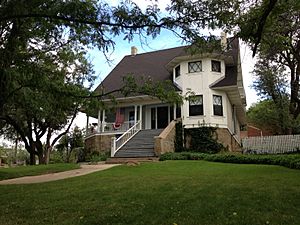
The Sharlot Hall Museum is a great place to learn about Prescott's history. You can also visit the Museum of Indigenous People and the Phippen Museum for local art and culture.
Prescott has many beautiful Victorian style homes. There are 809 buildings in Prescott listed on the National Register of Historic Places. The tallest house in North America, Falcon Nest, is in Prescott.
Prescott is famous for its downtown historical area called Whiskey Row. In 1900, a big fire destroyed most of the buildings there. Legend says that people from the bars simply took their drinks across the street to the Courthouse square to watch the fire. The Palace Restaurant & Saloon was rebuilt after the fire. It is now the oldest continuously operating business in Arizona. Whiskey Row is on Montezuma Street, west of the county courthouse.
Prescott is home to the "World's Oldest Rodeo," which started in 1888. It's also called "Frontier Days" and happens around the Fourth of July. This rodeo is very famous and brings in thousands of tourists. About 45,000 people also watch the Rodeo Parade through downtown Prescott. Prescott claims it was the first rodeo to charge admission and become a spectator sport.
Prescott hosts many annual events. These include Frontier Days, the Bluegrass Festival, art festivals, and a Cinco de Mayo celebration. There's also the World's Largest Gingerbread Village at the Prescott Resort. Other events are the Prescott Film Festival, parades, and the Acker Music Festival. On New Year's Eve, the "Prescott Boot Drop" happens on Whiskey Row. A large cowboy boot is lowered to celebrate the new year. Prescott also has the Heritage Park Zoo.
There are four golf courses in Prescott. These include Antelope Hills Golf Course and private clubs like Capital Canyon Golf Club.
Prescott is home to The Arizona Pioneers' Home. This place cares for people who helped build Arizona. It was built to house 40 men, and later added a wing for women. It also included a hospital for people who worked in mines.
Prescott is also home to Prescott College. This is a small college that focuses on environmental and social justice. It has about 800 students. Students can study on campus or through distance learning programs.
Prescott was the location of Arizona's first Elks Lodge. The Prescott Elks Lodge #330 was started in 1895. The Prescott Elks Opera House was built by the lodge in 1905.
Special Recognitions for Prescott
Prescott has received many special titles:
- In 1989, Arizona Governor Rose Mofford named Prescott "Arizona's Christmas City."
- In 2000, its Downtown Historic Preservation District was recognized.
- In 2004, it was named a "Preserve American Community" by First Lady Laura Bush.
- In 2006, it was one of a "Dozen Distinctive Destinations" by the National Trust for Historic Preservation.
- In 2008, the Yavapai Courthouse Plaza was called one of the first ten "Great Public Places" in America.
- In 2012, True West Magazine named it the Number 1 True Western Town of the Year. This Old House Magazine also called it one of the 61 Best Old House Neighborhoods in the U.S. and Canada.
Learning in Prescott: Schools and Colleges
Colleges and Universities
- Yavapai College
- Embry–Riddle Aeronautical University, Prescott
- Prescott College
Schools for Kids (K-12)
The Prescott Unified School District covers most of Prescott. A small part of the city is in the Chino Valley Unified School District.
Schools in Prescott include:
- Prescott High School
- Mile High Middle School (for 7th and 8th grades)
- Granite Mountain Middle School (for 5th and 6th grades)
- BASIS Schools
- Northpoint Expeditionary Learning Academy
- Tri-City College Prep High School
There are 18 public schools in the Prescott Unified School District, including five charter schools. There are also four private schools. In 2015, some elementary schools were closed due to budget cuts. Now, elementary schools go up to fourth grade. Granite Mountain Middle School serves fifth and sixth grades, and Mile High Middle School serves seventh and eighth grades.
Getting Around Prescott: Transportation
Prescott Regional Airport, Ernest A. Love Field (PRC) is about 7 miles (11 km) north of downtown. As of 2021, United Airlines has flights from Prescott to Denver and Los Angeles.
The three main roads in Prescott are Arizona State Route 89A, Arizona State Route 69, and Arizona State Route 89.
- State Route 89A connects to Sedona and Cottonwood.
- State Route 69 connects Prescott with Prescott Valley and eventually leads to Interstate 17.
- State Route 89 goes north and south, connecting Prescott to Chino Valley and Paulden.
In 2016, a part of Willow Creek Road was changed to include a roundabout near the airport. Yavapai Regional Transit provides local bus service connecting Prescott and Chino Valley.
Famous People from Prescott
Nearby Cities and Towns
- Chino Valley
- Groom Creek
- Iron Springs
- Highland Park, Yavapai County, Arizona
- Prescott Valley
- Wildwood Estates
- Yavapai Hills
Sister Cities
As of 2015, Prescott has three sister cities:
 Caborca, Sonora, Mexico
Caborca, Sonora, Mexico Suchitoto, El Salvador
Suchitoto, El Salvador Zeitz, Saxony-Anhalt, Germany
Zeitz, Saxony-Anhalt, Germany
Images for kids
See also
 In Spanish: Prescott (Arizona) para niños
In Spanish: Prescott (Arizona) para niños


